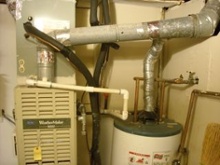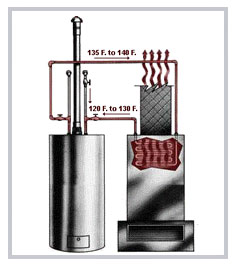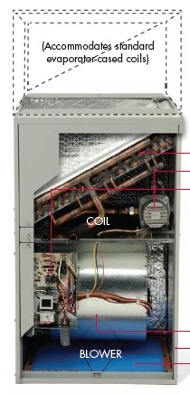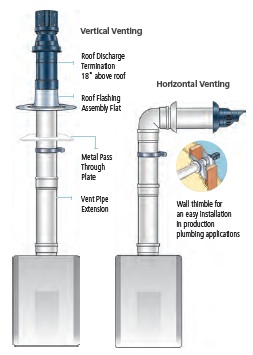Hydronic Furnace & Tankless Water Heater — A Great Combo!

 I’m embarrassed to admit it, but yes, that photo is the gas furnace and water heater in my condo. It’s an 80 AFUE (80% efficient) furnace and natural draft water heater. Notice also that they’re common vented, which can be a combustion safety problem. David Richardson calls this “one of the most dangerous installations allowed by code.”
I’m embarrassed to admit it, but yes, that photo is the gas furnace and water heater in my condo. It’s an 80 AFUE (80% efficient) furnace and natural draft water heater. Notice also that they’re common vented, which can be a combustion safety problem. David Richardson calls this “one of the most dangerous installations allowed by code.”
I’m embarrassed to admit it, but yes, that photo is the gas furnace and water heater in my condo. It’s an 80 AFUE (80% efficient) furnace and natural draft water heater. Notice also that they’re common vented, which can be a combustion safety problem. David Richardson calls this “one of the most dangerous installations allowed by code.”
The good news is that soon I’ll be replacing both of these combustion appliances to improve safety, energy efficiency, and comfort in our home. What I’ve decided to go with is a hydronic furnace that gets heat from a tankless water heater. It’s a nice configuration makes a lot of sense.
Here’s how it works. The water  heater does two jobs — it heats the water that we’ll use in the house, and some of that hot water is piped over to the hydronic furnace to heat the air passing over the hydronic coil. The image at right, from Firstco, shows the setup.
heater does two jobs — it heats the water that we’ll use in the house, and some of that hot water is piped over to the hydronic furnace to heat the air passing over the hydronic coil. The image at right, from Firstco, shows the setup.
The schematic here shows a conventional, tank water heater, which works fine for this application, too. You just have to make sure the capacity of the water heater, whatever kind you choose, is great enough to handle both the domestic hot water needs and the heating load of the house. (In case you’re new here, I’ll point out that Energy Vanguard does HVAC load calculations, so if you’re in the market for a new system, we can help you.)
Instead of two combustion  appliances, this type of combo or integrated system means you need only one. (Although it may be possible to do this with electric water heating, it’s not a good idea.) The two main companies that I know of that make hydronic coils, available by themselves or packaged in an air handler to make a hydronic furnace, are Firstco and Rinnai. I haven’t decided yet which one we’ll go with. At left is a photo of the innards of the Rinnai hydronic furnace.
appliances, this type of combo or integrated system means you need only one. (Although it may be possible to do this with electric water heating, it’s not a good idea.) The two main companies that I know of that make hydronic coils, available by themselves or packaged in an air handler to make a hydronic furnace, are Firstco and Rinnai. I haven’t decided yet which one we’ll go with. At left is a photo of the innards of the Rinnai hydronic furnace.
I really like the idea of this type of integrated system. It’s simple, and in our case, it’s going to be much safer and more energy efficient than what we have now. We could use the blower in our current furnace and just add a hydronic coil, but we’re already using all the vertical height available in the room. By replacing the whole gas furnace, we’ll get a new, more efficient blower as well. I’m not sure about the Firstco model, but the Rinnai has an EC motor (sometimes called an ECM motor, which is equivalent to saying ATM machine or PIN number because the M already stands for motor). I’ll write another article sometime on the difference between the electronically commutated motor (ECM) and standard Permanent Split Capacitor (PSC) motor, but all you need to know here is that the ECM can be much more energy efficient.
My strongest motivation in wanting to do this is to get rid of the natural draft water heater, with its combustion saftey issues and possibility for backdrafting. I really don’t want to wake up dead* some day because of carbon monoxide poisoning. So, what I’d like to do is replace it with a high efficiency, condensing, tankless water heater, as shown at right. I’m not a huge fan of tankless water heaters just for the sake of ‘being green.’ They may or may not save energy because the fact that they can keep pumping out the hot water continuously means that you may end up using more hot water than you would with a tank. When it’s part of an integrated system like this, though, I think it makes a lot of sense.
motivation in wanting to do this is to get rid of the natural draft water heater, with its combustion saftey issues and possibility for backdrafting. I really don’t want to wake up dead* some day because of carbon monoxide poisoning. So, what I’d like to do is replace it with a high efficiency, condensing, tankless water heater, as shown at right. I’m not a huge fan of tankless water heaters just for the sake of ‘being green.’ They may or may not save energy because the fact that they can keep pumping out the hot water continuously means that you may end up using more hot water than you would with a tank. When it’s part of an integrated system like this, though, I think it makes a lot of sense.
So, that’s my plan. I hope to be able to do it sometime in the coming year and will definitely write more about it once I get going with the project.
Related Articles
Just Say No to Furnaces in High Performance Homes
Heat Pumps and Hydronics – A Great Team for High Performance Homes
3 Problems with Atmospheric Combustion Inside the Building Envelope
*Tip of the hat for that expression to my 10th grade industrial arts teacher, Mr. Jackson, who liked to lecture to some of the guys in our class about their behavior.
This Post Has 25 Comments
Comments are closed.

Extremely common in Canada.
Extremely common in Canada. The only thing that concerns me is flow rate. I’ve seen the tankless unit sized way too small and it may deliver great efficiency, but marginal performance.
Depending on your heat load you may want to think about a small buffer tank for hot water on the heating circuit. This can help with the mismatch between the capacity of the unit and the actual heat load of the house. Particularly in the shoulder seasons.
-Rob
Rob: Good
Rob: Good point! Our heating load will be really small (less than 20,000 Btu/hr) when I’ve finished with some of the envelope improvements I’m going to make. I definitely want to make sure we have enough capacity for both our hot water and heating needs on the coldest days, and a buffer tank is certainly a good option. Thanks for bringing that up!
Did you consider that your
Did you consider that your domestic hot water will get contaminated when tied into a hydronic air handler? The hydronic system should be be on it’s own, and not tied to the domestic hot water.
In the mid-90’s I replaced my
In the mid-90’s I replaced my Heat Pump with a Hydronic furnace ( I could not ventelate a Gas furnace but I could run hot water lines from the attic to the downstair unit) It has worked great. My 50 gal, newly replaced, high efficiency Hot Water heater does a great job and I can even bi-pass it to the 2nd hotwater heater if need be. A big benefit is the fact that the air is not near as dry as a gas furnace and my skin does not dry out near as much in the winter – Bill S
Very informative, as I’ve
Very informative, as I’ve found all your articles and comments.
@Allison – The buffer tank is
@Allison – The buffer tank is a key component, especially when you consider how little water will actually be in that hydronic loop.
.
@Miguel – While technically you are correct, the same water will be DHW and heating, I don’t see where the “contamination” comes from.
.
Especially when the air handler coil and all other components are new and made of PEX / brass / copper / no lead solder / potable water rated, etc. This line of thinking comes from “the old days” when hydronic heat meant rusty cast iron radiators, etc. The galvanized DHW lines I removed from my house didn’t look particularly appetizing on the inside, but they were legal.
.
I personally have been feeding DHW through baseboard heat for over 10 years. You simply have all the components be potable water rated. My baseboard uses a Taco 005 bronze potable water rated circulator pump.
.
It’s very common now, called an open system. Likely hundreds of thousands installed like this.
-Rob
Miguel’s comment above bears
Miguel’s comment above bears some consideration. Your only concern would be with the water remaining stagnant in the air handler during spring/summer/fall when not in use. It could become a breeding grounds for ooky stuff. A simple circulator exercise control feature would take care of the problem…just run the circulator for a few minutes every few days to prevent stagnation. The Rinnai, I believe, may have the functionality built in.
A useful document on the
A useful document on the topic:
Government of Alberta, Alberta Municipal Affairs – Safety Services: Requirements for Combination Heating Systems: Dual Purpose Water (Potable) Heater (Combo Unit)
I really wish I took this
I really wish I took this into consideration when I replaced my old furnace last year since I installed a Rinnai water heater a few years ago. Oh well, all combustion saftey/backdrafting issues have been removed from my home, and that was my goal.
Ahh, the Cobbler’s children
Ahh, the Cobbler’s children have no shoes! 😉 J/K
This method of heating is interesting to me. I’ve got a 24 kBTU/hr (calculated) heat load (@68ºFin / 23ºFout) with 78 kBTU/hr output. This could be easily covered by my 40 kBTU/hr water heater.
Yes, the Rinnai hydronic pump circulates water for two minutes every 6 hours even if there is no furnace demand.
FWIW we have the same setup
FWIW we have the same setup in our home as you do in the Condo. Even the furnace brand is the same. Our furnace is a whopping 88,000 BTU for a 1587sf house built in 2000 in Oklahoma. Actual heating load is only about 40,000BTU. We’re considering a setup like your talking about when the furnace or water heater goes out.
That being said our previous house had no central heat/air and I installed a “hrydoair” type system but used a regular 40 gallon water heater. The blower/coil unit has 2 circuits, one for water, the other for refrigerant. The house is less than 800 sq ft so the conventional gas water heater had plenty of power most of the time. The main drawback is when you take showers/wash clothes of other thing that are “tank drainers” heat output suffers on the colder days. Otherwise it works really well since it’s difficult to find small enough furnaces to properly match the small heating requirement.
Also wanted to point out,
Also wanted to point out, this IS a great option for homes with low heating loads. The smallest Nat Gas furnace I ever found was 28,000 btu. After that you have to go to wall heaters or RV furnaces – which I’ve done, but they are low (80 ish?)efficiency.
.
But once your heat load is that low the savings from increased efficiency go away.
-Rob
we’ve seen lot’s of these
we’ve seen lot’s of these systems as well. Good for low loads, though we’ve seen a pretty widespread failure of earlier generation systems as well. The efficiency of course, is not what you could get with other systems for heating anyway, but that may be overblown, so all in all, probably a good system for you.
Another informative and
Another informative and concise post, Allison. When considering the ECM unit, give strong consideration to restrictions and friction rate in the duct system. ECMs perform well, but they aren’t magic. They use a lot of energy when they have to “ramp up” to supply the right flow.
Interesting article. Hydronic
Interesting article. Hydronic fan coils also work well as supplemental heat for heat pumps. In that case, the refrigerant coil must be *upstream* of the hydronic coil so they can operate simultaneously. This is the problem with dual-fuel furnaces.
Steve mentioned problems with earlier systems. This was because tankless water heaters are designed for open-loop (dhw) applications with short run times.
I recently spoke with a Rinnai engineer about this, noting that Rinnai also sells combi-boilers for space heat and dhw. He said their hydronic air handlers are designed to work with their water heaters. What you can’t do is use a tankless water heater in a closed loop application. In other words, the primary purpose must be for domestic hot water without an indirect heat exchanger.
Rinnai’s combi boilers have two heat exchangers as well as built in controls for outdoor reset. They cost about twice as much as a similarly sized instant water heater. He recommends boilers for homes with large heat loads and/or closed-loop hydronic space heat (slab or baseboard loops).
Thomas:
Thomas: Your point about ECM is correct. They save the most when operating against a low-static duct system. However, ECM’s are still more efficient than PSC motors at higher static pressures.
Also, your point about “ramping up” is a bit misleading. Only variable speed blowers are designed to maintain constant CFM, a feature found on many, but not all variable speed furnaces and air handlers.
The term ECM is commonly used to refer to non-variable designs, even though variable blowers are based on the same EC motor core.
BTW, for the reason you said, I think the “constant CFM” often becomes a crutch for poor duct design and filter maintenance.
You may also want to look
You may also want to look into the warranty on the tankless water heater that you choose. Some models are not acceptable to be used in heating applications (whether closed or open loops) and may void warranty.
Most of the time they require that you utilize the commercial tankless models.
It’s not a focus of this
It’s not a focus of this particular article, but how would you tie A/C into your proposed hybrid system? Does the air handler care if it’s pushing DHW/hydronic over the coils or refrigerant?
Would the hybrid system work in more extreme weather zones?
Have you done an analysis of the estimated cost savings?
Thanks for the thought-provoking article.
There are alot of systems out
There are alot of systems out there like this originally with tank heaters. Now that the perceived higher efficiency of tankless is available but trust me in this application it is not. ANZI allows for water heaters in this combi application as long as there is at least one fixture drawing making this a open system. Biggest drawback especially with tankless in this app is the newer air handlers do have pump exercising and the downfall is it creates flow through tankless, thus it fires. So you have the tankless firing, cycling and heating when not desired, even during air conditioning season.
Kevin: It
Kevin: It doesn’t matter if a straight cooling coil is upstream or downstream of the hydronic coil. However, a heat pump coil should always be on the supply side of the hydronic coil else the warm air exiting the hydronic coil will boil the refrigerant. So with the Rinnai hydronic air handler, the heat pump coil is mounted in a separate enclosure on the return end. With a regular air handler, the hydronic coil is mounted in a separate enclosure on the supply end. Make sense?
I routinely specify heat pumps with hydronic supplemental heat in cold climate zones such as Montana and Minnesota. Unless you pay higher than average rates for electricity, a mid-efficiency heat pump costs less to operate than a high efficiency gas furnace or hydronic fan coil. In fact, the colder the climate, the longer the heating season and the more heating hours above the heat pump’s thermal balance point. The only time I don’t specify a heat pump as primary heat is when the marginal winter electric rate is higher than about 12 cents, or in areas where central air isn’t needed. But in areas where natural gas isn’t available, a heat pump will nearly always cost less to operate than the alternatives. The question in that case is how best to provide supplemental heat.
As for savings, it all depends on what you’re comparing it to. Keep in mind that it costs about the same to heat with a hydronic fan coil as a conventional furnace with similar efficiency. Rinnai’s Ultra line of water heaters are rated at up to 96%. So if gas costs $0.96/therm, then a 96% tankless water heater or forced air furnace will cost about $1.00 per therm plus about 5 or 6 cents per therm for blower energy (assuming ECM).
BTW, at 10 cents a kWh, a 15 SEER single stage heat pump costs about 73 cents/therm (10 x 29.3 / 4 COP). The COP already includes blower energy.
Finally, there are two reasons to consider a hydronic fan coil:
1) if the heat load is substantially less than the smallest capacity furnace, or
2) if the primary heat source is a heat pump and the seasonal supplemental load is large enough to justify the additional first cost (compared to electric strips).
Allison,
Allison,
Don’t forget the thermostatic mixing valve between the water heater and your household fixtures…. You don’t want to scald anyone
Carl: A
Carl: A mixing valve is unnecessary in this application. Allison’s load is less than 20k btu/hr. The Rinnai air handler has 28k btu/hr capacity @ 120F entering water temperature. Setting the heater’s maximum temperature higher than necessary will lead to short cycles at peak load, which will cause temperature droop at the perimeter (see first article in “Related Articles” list above).
David, Good point
David, Good point
I was looking at the diagram above showing 135 to 140 degree water being supplid to the air handler
I’ve installed hundreds of
I’ve installed hundreds of combo system, mostly using the Polaris water heater. I always use potable water, even for in floor heating, never had a problem, works very well. Its the only system I would use in my own home.
A question for the HVAC
A question for the HVAC professionals reading this. We are in Dallas, TX and have a 3 year old Hydronic system using a Rinnai tankless water heater and an air exchanger that has an evaporator coil that has a lot of rust around the U shaped copper tubes that loop around the ends of the evaporator coil. What causes this and what is the proper way of treating the issue before it fails?